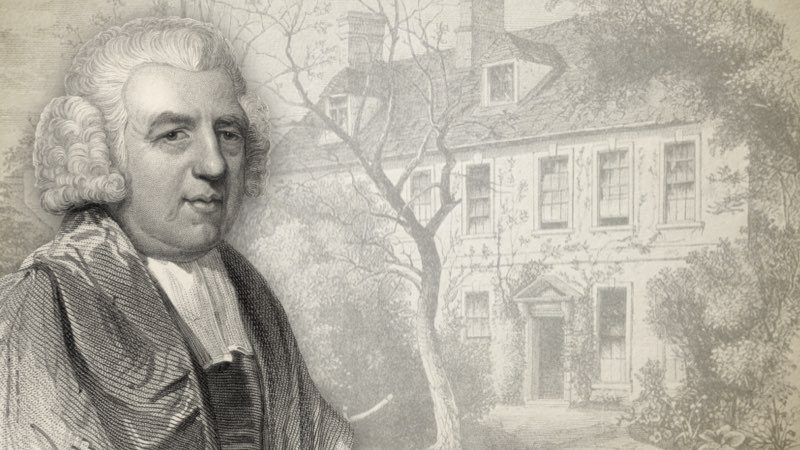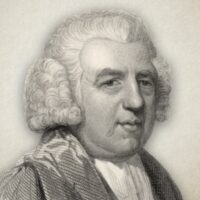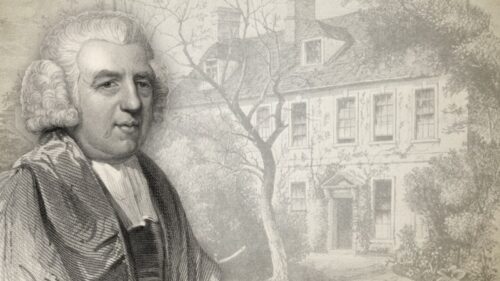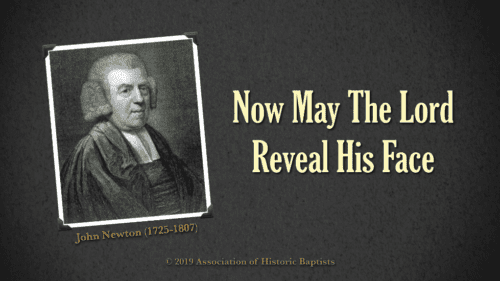
The Removal Of John And Mary Newton’s Caskets
Earthen Vessel 1893:
From the Bedfordshire Times and Independent
On Wednesday, January 25th, 1893, a ceremony of singular interest was celebrated at Only Church, when the remains of John Newton, and of Mary, his wife, were re interred in the parish churchyard. The following is a an extract from his will, which will be read with interest:—
“In the name of God, Amen. I, John Newton, of Coleman-street-buildings, in the parish of St. Stephens, Coleman-street, in the city of London, being through mercy in good health, and of sound and disposing mind, memory, and understanding, although in the seventy-eighth year of my age, do, for the settlement of my temporal concerns, and for the disposal of all my worlds estate which it has pleased the Lord in His good providence to give to me, make this my last will and testament as follows: I commit my soul to my gracious God and Saviour, who mercifully spared me when I was an apostate, a blasphemer, and an infidel, and delivered me from that state of misery, on the coast of Africa, into which my obstinate wickedness had plunged me, and who has pleased to admit me (though most unworthy) to preach His glorious Gospel. I rely with humble confidence upon the atonement and mediation of the Lord Jesus Christ, God and man which I have often proposed to others as the only foundation whereon a sinner can build his hope, trusting that He will guard and guide me through the uncertain remainder of my life, and that He will then admit me into His presence in His heavenly kingdom. I would have my body deposited in the vault under the parish church of St. Mary Woolnoth, close to the coffins of my late dear wife, and my dear niece, Elizabeth Cunningham; and it is my desire that my funeral may be performed with as little expense as possible consistent with decency.”
John Newton’s early career was full of adventure and eventful incident. Born in 1725, he was sent as a lad to sea, and went on many voyages, and suffered a variety of hardships. At one time he practically became a slave, and was treated with great cruelty on the coast of Africa. but was rescued by a passing ship which happened to belong to his father’s friend. At a time when, according to a publication by the Religious Tract Society, slave-holding and slave-dealing were regarded as consistent with religious profession and the strictest orthodoxy, Newton seems to have been engaged in the slave-trade. The history of his spiritual experience is full of vivid interest, and he took no small part in the religious revival of the last century, his name being more prominently associated with the evangelical movement in the Church. Having after some difficulty, obtained ordination, he succeeded Moses Browne in the curacy of Olney, where he prepared the well-known Olney hymns, and in this work his coadjutor was the poet William Cowper, and it is some of these hymns which have immortalized his name.
He was on terms of warm friendship with Joshua Symonds, minister of the Bedford Bunyan Church, with William Bull, of Newport Pagnell, and with Thomas Scott, a curate in a neighboring parish. He was also intimate with the Wesleys and George Whitefield. In 1780 John Newton accepted the living of St. Mary Woolnoth, Lombard-street, where he remained until his death in 1809, his wife having died in the winter of 1790. Both bodies were deposited in the vaults of St. Mary Woolnoth, where they remained until their removal to Olney on Tuesday, Jan. 24th. John Newton was born in London on the 24th of July, 1725, old style, and perhaps the briefest possible memoir of his life is to be found in the following epitaph in St. Mary Woolnoth Church, which he himself composed:
JOHN NEWTON, Clerk, Once an infidel and a libertine, A servant of slaved in Africa, Was, By the rich mercy of our Lord and Saviour Jesus Christ, Preserved, restored, pardoned, and appointed to preach the faith he had long labored to destroy. He ministered Near 16 years as curate and vicar of Olney, in Bucks., And 28 as rector of these united parishes. On February the first, 1750, he married Mary, Daughter of the late George Catlett, of Chatham, Kent, Whom he resigned to the Lord who gave her on Dec. The 15th, 1790.
Newton died on the evening of Monday, Dec. 21st, 1807 and was buried in his church on the 31st of that month, in the vault which contained the remains of Mrs. Newton.
For sanitary reasons an order in council was recently issued, directing the removal of the bodies, some 3,000 in number, from the crypt of St. Mary Woolnoth to Ilford Cemetery. By the exertion of a few interested persons, headed by Mr. J. T. Maitland, of Croydon, in conjunction with the rector of the Church (.l. M. S. Brooke) a special order was obtained for the re interment of the bodies of John Newton and his wife in Olney Churchyard. It was thought befitting that a place, to which cling so many interesting memories of the deceased, where Newton himself had laboured with great earnestness, and produced the poems which have been keenly appreciated all over the English-speaking world, should receive these remains. Subscriptions were asked for to defray the expenses, and the greater part of the sum has been raised, but Mr. Maitland, of 12, Wellesley-road, Croydon, is open to receive further contributions. Messrs. Dove Bros., builders, of Islington, prepared the new oaken cases which enclosed the original metal shells, that of Mr. Newton being of an alloy, and that of his wife was of lead. Mr. Dove ways the two coffins, with two others, lying above them, were found immediately under the chancel of the church.
The shells were not opened, but were screwed down in the new coffins in the presence of Mr. Maitland, Mr. Hinton, and others. They were taken in a hearse from the church to St. Pancras station, accompanied by Mr. Maitland, Mr. Hinton and Mr. F. L. Dove, the two former having legal custody of the bodies. On their arrival at Olney station they were removed to the church in a hearse, one at a time. They were met at the station by Mr. T. T. Coles, one of the church-wardens of Olney parish, and a large number of people. A bricked grave was prepared to receive the remains in the extreme northern corner of the churchyard—a picturesque spot sheltered by an old and high wall, which may have been there at the time the grave was first prepared to receive the remains of Mrs. Newton’s father, George Catlett, who was buried in 1777. A square tombstone records that George Catlett was late of Chatham, Kent, and father of Mary, wide of John Newton.
A light mist veiled the Ouse Valley on Wednesday morning, but it disapproved by noon, and the weather was bright and cheery. Half-past twelve was fixed for the ceremony at the church. A large contingent of distinguished visitors from London came down by the last arriving train, among them being Canon Benham, Sir Henry Peck, Bart., Mr. W. H. Collingridge, Mr. George Collingride, Mr. E. W. Matthews, Mr. Densham, Mr. W. M. Cross, Mr. Shillingford, chairman of the Gospel Standard Aid and Poor Relief Societies. Among others present were Mr. Thomas Wright, Dr. Edward Wilkinson, Mr. C. M. Amos, Mr. G. F. W. Munby, Mr. J. R. H. Duke, Mr. .T Linnell, Mr. G. Carruthers, Mr. I. Ashton, Mr. Croxton, Mr. H. Bradford, Mr. G. Whitehead, Mr. G. P. Soames. Mr. Garrard, represented by Mr. A. Allen, and Mr. Coles rendered every assistance. The full service for the burial of the dead was read.
Early in the afternoon a luncheon was provided. Mr. W. H. Collingridge, by whose hospitality the visitors were entertained, presided, and about forty sat down to dinner. During the few minutes that remained before the visitors caught the next train to London, the chairman said he would ask Canon Benham, who had favoured them with his presence, to speak a few words as to the character they had met to bury.
Canon Benham said he need not speak of the life of John Newton, who was well known to all present. It was the story of the profligate, the infidel, the mathematical student, the classical student, the slave in Africa upon whom other slaves used to take pity, and to whom they gave a few crumbs to save him from starving; the infidel reading Thomas a Kempis and the Bible—such was the early life of John Newton as a sailor. On one occasion he deserted and was flogged. In his wretchedness he went away to commit suicide, but was restrained by the memory of Mary Catlett, whose coffin they had just seen lowered into the grave. He saw her as a girl of fourteen; he loved her at first sight, remained faithful to her for so many years, married her at last, and declared that by the providence of God he was saved from committed suicide by the memory of her sweet face. They had sung that morning the hymn which he need not read, for everybody remembered it so well—a hymn which had touched more or less so many hearts and comforted every soul in that gathering. He had with him the first edition of the Olney hymns, and one had struck him as so thoroughly characteristic of Newton. It began:—
“Lord, Thou has won, at length I yield;
My heart, by mighty grace compelled,
Surrenders all to Thee;
Against Thy terrors long I strove,
But who can stand against Thy love?
Love conquers even me.”
Canon Benham quoted the remaining verses of the hymn, and added that it was a wonderful poem, for it was the history of a man’s soul. His attention was called to it that morning by Dr. Doudney, and he (Canon Benham) was fascinated by it. When Europe was torn almost to pieces by the French Revolution, and the principles of that Revolution were promulgated in this country by tracts written in English, it was the influence of John Wesley and John Newton that saved England from going to wreck as the French nation did. Another notable name was that of Legh Richmond. In the south of England next to “The Pilgrim’s Progress,” no book was read so much as “The Dairyman’s Daughter.” By the kindness of Mr. Collingridge, he (Canon Benham) once went over to the village in the vicinity, and saw “the original manuscripts of Legh Richmond. Henry Venn., his grandfather, was Newton’s curate. A man’s work did not end with himself.
Sir Henry Peek proposed a sincere vote of thanks to Mr. Collingridge for his kindness and courtesy, and said they were also much obliged to Canon Benham for his remarks. He did not know until today that Mr. Collingridge was a native of Olney, but it appeared he was actually born in the house of which they had heard so much that day. Long might he be preserved to benefit society at large, and Olney in particular.
Dr. Wilkinson, of Leamington, seconded, and spoke of the great pleasure of being present when so many friends of John Newton were thrown together by the bond of union, which is truth. It is gratifying to find that John Newton’s religion had been commended by Canon Benham as one founded on Christ: for he had lately discovered that since the establishment of Christendom the Pope and others had substituted “Churchianity” for Christianity. Lately he had been reading Newton’s lines on “What think ye of Christ?” and he commended the following to their attention:—
“What think ye of Christ? is the test,
To try both your state and your scheme?
You cannot be right in the rest
Unless you think rightly of Him.”
The chairman said they were especially grateful to see present Mr. Thomas Wright, the author of what he considered was the only Life of Cowper. Mr. Thomas Wright, in the course of a few remarks, which he had not time to complete, said Canon Benham’s biography had been very helpful to him in the preparation of his work. Most of the company then made their way to the station. Canon Benham, who was facile princeps in the local topography, pointing out spots described in Cowper’s poems and quoting ad. lib. in a manner that was most appropriate and entertaining.—From the Bedfordshire Times and Independent.
John Newton (1725-1807) was an English Anglican preacher, hymn writer and humanitarian. Prior to faith in Christ, he served as the captain of slave ships and made a living in the slave trade. After his conversion to Christ, he renounced slavery and became one of the leading abolitionists in England. He was ordained a cleric in the Church of England serving as parish priest at Olney, Buckinghamshire, for twenty years. Among Evangelical circles, he is best known for his hymns, among which are “Glorious Things Of Thee Are Spoken” and “Amazing Grace”.
John Newton Hymn Studies





